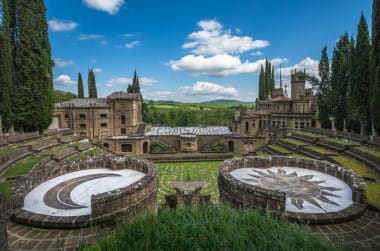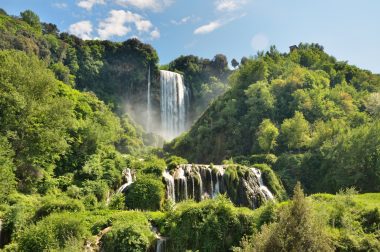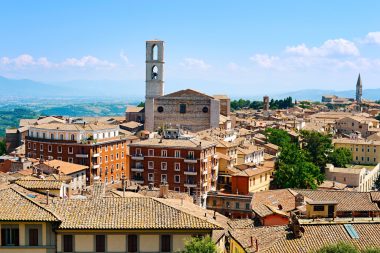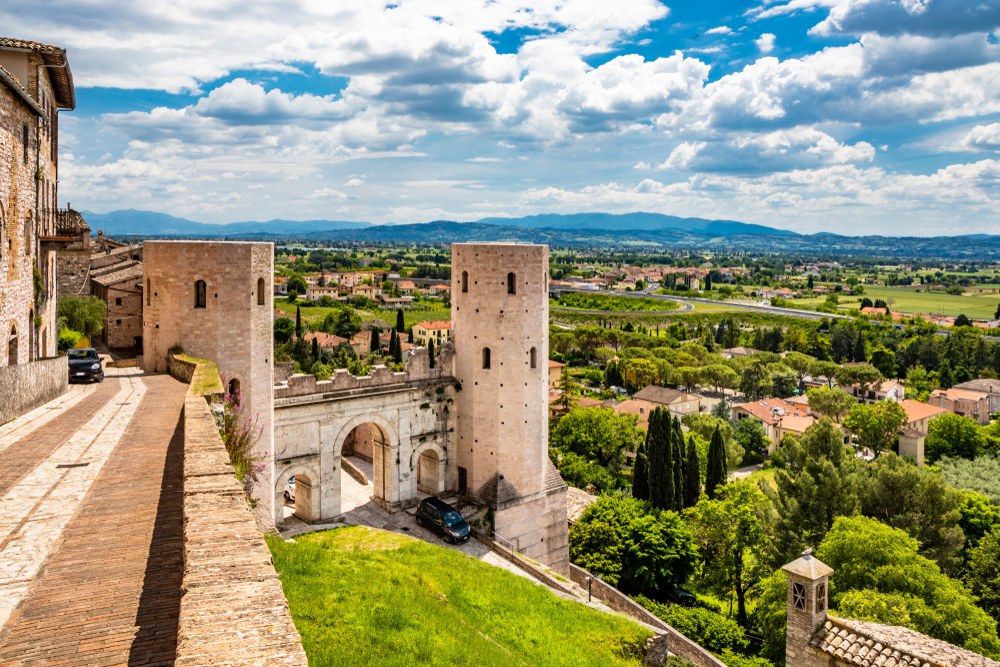Umbria is one of four regions of Italy that do not border the sea – perhaps that’s why it was left behind for a long time, on the way south, towards Rimini, Capri or Rome.
Admittedly, this stretch of land in northern Italy is no longer a real insider tip, but many areas there are nowhere near as crowded and overused for tourism as elsewhere in Bella Italia.
Umbria is located east of Tuscany and above the Lazio region and consists of 93% mountains and hills. The remaining seven percent hides wide plains with beautiful lakes and widely branched rivers, almost all of which flow into the Tiber, which flows through Umbria’s north. In the east of the country, in the direction of the Marche, there are high mountain ranges, the highest point of which is Monte Vettore (2476 m). Towards the west, the mountain ranges gradually turn into gentler hilly landscapes. By far the largest lake is Lake Trasimani near the city of Perugia.

Umbria – High in the rocks rise venerable abbeys and mighty towers
A land of green and grey, that’s how Umbria looks at first glance, but on closer inspection the land unfolds its austere beauty, which is characterised by medieval – partly Romanesque – towns and villages that proudly lean against sublime rock massifs or are enthroned on velvety hills.
Cities with thousands of years of history nestle on the mountain slopes
The name “Umbria” goes back to the Umbrian people, who settled the area permanently around the year 1000 AD and also developed their own language – Umbrian.

The capital is Perugia, which with its more than 165,000 inhabitants is by far the largest city and at the same time the center of the province of the same name. Perugia was already inhabited in the Iron Age (around 900 BC) and experienced a high cultural flourishing at the time of the Etruscans in the 5th century BC. The arch of the Arco Etrusco from the 3rd century BC, which is still preserved today, bears witness to this time. Also worth seeing is the Gothic cathedral, which was built from the 14th century onwards, to name just a few of the numerous historic buildings in the old town of Perugia. The Galleria Nazionale dell’Umbria, which houses a comprehensive collection of art objects from the Middle Ages, is of supra-regional importance. The “Archaeological Museum of Umbria” is also located in Perugia.
The city is famous for its “Baci Perugina” (Perugin kisses), a praline speciality made from nougat and whole hazelnuts, which is often bought as a souvenir, but preferably eaten on the spot.
Terni, the second largest city in the region, also has a lot of ancient things to offer, for example in the form of a Roman city gate or an amphitheater theater, which is now used for music and theater performances. In Terni there is a picture gallery that has included works by both Old Masters and contemporary artists.
Behind fortified walls hide great art treasures and a lot of Italian flair

A special feature of many Umbrian towns and villages are the narrow streets that lead to inviting squares in the centre of the village, which are surrounded by imposing palazzi and sacred buildings – typically Italian, there is also a large fountain where you can cool yourself.
Umbria is called “the land of the saints”. This is probably due to the unbroken radiance of the Holy See. Francis of Assisi, who was born around 1182 in the Umbrian city of Assisi. He was the son of a merchant family and later founded the Franciscan order, which was dedicated to poverty and service to the poor and sick. His tomb is located in the church of St. Peter. Francis in Assisi.
Gothic art flourished masterfully in Umbria
Particularly worth seeing is Gubbio, which is located about 35 km northeast of Perugia. On its “Piazza Grande” stands the Prior’s Palace, whose bold monumental building is described as the most important secular building of the Italian Middle Ages. What is not recognizable at a first glance at its front: it was built on a steep slope. Its entire ground floor consists of a single hall.
As in many Umbrian villages, the Duomo of Spoleto is located in the heart of the old town at the end of a large staircase. Built from 1175 onwards, it is a witness to Gothic architecture. Its interior is illuminated by eight rose windows, of which the rose in the centre is described as “the most beautiful rose window in northern Italy”.
The Basilica of San Salvatore was built in the 5th century around the interior of a Roman temple and is considered a valuable testimony to early Christian culture. In 2011, it was added to the UNESCO World Heritage List.
The Rocca Albornoziana, a papal castle from the 14th century, is of great cultural and historical importance. At the foot of the castle complex is the “Ponte delle Torri”, the bridge of towers, which, with its enormous dimensions of over 200 m long and 76 m high, is an example of the impressive skill of the medieval builders.
Simple beauty during the day – the evening plays with a wide range of colours
Umbria’s special charm can be experienced most impressively in the evening atmosphere, when the hustle and bustle has subsided – best from a vantage point on one of the striking hills overlooking the plain, when the sun bathes the land once again in magical colours before sinking behind the mountains.
“Umbrian Night”, says a poem by Paul Celan (1920 – 1970), “with the silver of the bell and the olive leaf”. There is no better way to describe it.
Holidays in Umbria: The best tips
Journey
- Airports:
- Perugia San Francesco d’Assisi – Umbria International Airport (PEG): About 12 km from Perugia, the main gateway to Umbria.
- Florence (FLR) and Rome (FCO, CIA): Both airports offer train and bus connections to Umbria.
- Train: Good connections from Rome and Florence to Perugia, Assisi, Spoleto and other cities in Umbria.
- Car: Arriving by car allows flexibility and makes it easier to explore rural areas.
Best time to visit
- Spring (April to June): Pleasant temperatures and blooming landscapes, ideal for outdoor activities and city tours.
- Autumn (September to October): Harvest time for wine and olives, mild weather and colourful landscapes.
Activities and sights
- Historic Cities: Visit Perugia, the capital of Umbria, with its narrow streets and the impressive Fontana Maggiore. Assisi, the hometown of St. Francis of Assisi, is famous for the Basilica of San Francesco.
- Nature experiences: Explore Lake Trasimeno, the largest lake in central Italy, and Monte Subasio, which offers great hiking opportunities.
- Wine tastings: Visit wineries in Montefalco, known for the Sagrantino wine, and Orvieto, famous for its white wine.
- Culture: Experience the Umbria Jazz Festival in Perugia in July and the Festival dei Due Mondi in Spoleto in summer.
- Food tours: Taste the famous black truffles of Norcia and the excellent olive oils from the region.
- Outdoor activities: Hiking, cycling and horse riding are popular activities in the Umbrian countryside.
Places to visit
- Perugia: The capital of the region with its historic old town, the university and numerous museums.
- Assisi: UNESCO World Heritage Site and home to the impressive Basilica of San Francesco.
- Spoleto: A city with a rich history and a famous summer festival, the Festival dei Due Mondi.
- Orvieto: Famous for its Duomo and the underground caves and tunnels.
- Gubbio: A well-preserved medieval town, known for its traditional festivals and breathtaking scenery.
Accommodation
- Luxury Hotels: Numerous luxurious hotels and historic residences offer first-class comfort and service.
- Agriturismo: Stay on a farm and enjoy homemade food and wine.
- Bed & Breakfast: Cozy accommodations in historic buildings and charming villages.
- Holiday rentals: Ideal for families or longer stays, numerous apartments and country houses are available for rent.
Culinary tips
- Regional cuisine: Try dishes such as wild boar stew, truffle pasta and the famous Umbrian sausage from Norcia.
- Wine: Taste local wines such as Sagrantino di Montefalco and Orvieto Classico.
- Olive oil: The region is known for high-quality olive oil, which you can buy directly from the producers.
- Markets: Visit local markets to discover fresh produce and regional specialties.
Practical tips
- Car rental: A car gives you the flexibility to explore the region’s various places and attractions.
- Public transport: Good train and bus connections between the larger cities and tourist destinations.
- Currency: The local currency is the Euro (EUR). Credit cards are accepted in most shops and restaurants.
- Language: Italian is the official language, but English is often spoken in tourist areas.
Safety
- Crime: Umbria is considered very safe. Usual precautions as in any tourist region are advisable.
- Health: There are numerous pharmacies and medical facilities in the region. Travel insurance is recommended.


